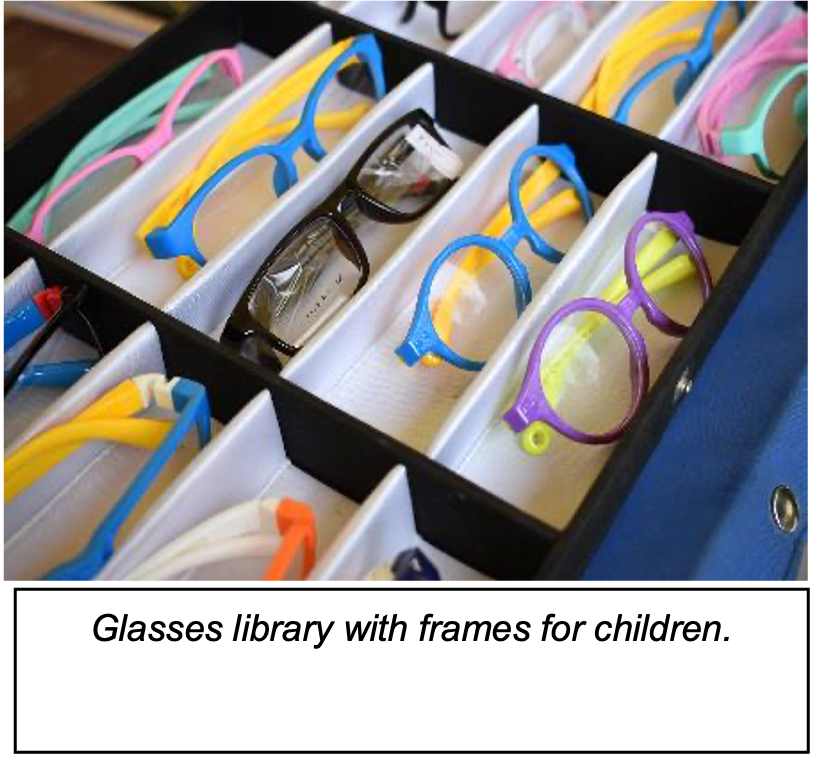Refractive Error Among CHildren (REACH): A Lens on the Future
REACH operates with three objectives: 1) eliminate barriers to eye health for school children; 2) improve the quality of school eye health services; and 3) create a positive, sustainable environment at schools where eye health services are provided, ensuring children feel comfortable to access these services.
A pair of glasses can provide so much more than clarity of vision. It can dramatically change someone’s life, especially for children. Visual impairment often leads to poor academic performance, missed opportunities, and social exclusion. Refractive error is one of the most common causes of visual impairment among children aged 5-15 years. It is responsible for up to 77 percent of blindness and severe visual impairment globally.1 India has nearly 680,000 blind children, the highest of any country in the world. About one third of these children have uncorrected refractive error (URE).2 But the good news is that the financial, economic, and social burden of refractive error can be prevented and mitigated with regular eye check-ups and timely interventions.
Image courtesy of Orbis

School-based eye health interventions have the potential to provide high-quality and cost-effective services to a vast cohort of school-aged children. It allows for early detection, prevention, and appropriate management. Orbis International, a global nonprofit fighting avoidable vision loss, is working with its partners to combat this issue for school children in India. The Refractive Error Among CHildren (REACH) program aims to reduce visual impairment due to URE among school-going children3 and has been instrumental in improving the lives of over five million children across the country.
REACH operates with three objectives: to eliminate barriers to eye health for school children; to improve the quality of school eye health services; and to create a positive, sustainable environment at schools where eye health services are provided, ensuring children feel comfortable to access these services.
Orbis, along with its partners, deploys teams of eye care professionals to schools to perform vision screenings. During these screenings, teams prescribe and provide glasses as well as refer children with eye conditions requiring surgery to local Orbs partner hospitals for further examination and treatment. To increase uptake of services and encourage children to wear their prescribed glasses, children can bring their friends to help them choose their favorite frames. REACH also monitors children’s compliance with wearing their glasses and increases awareness of eye health. Children identified as requiring further examination or intervention are referred to the nearest vision center.
Engaging students and teachers
REACH engages students to further the success of the program. Select students are identified as Vision Ambassadors and are encouraged to help identify children with refractive error, advocate for the use of glasses among their peers, and help overcome the stigma attached to wearing glasses, such as being teased for looking different or being called names. Schoolteachers are also engaged in the program and provide key support. They help facilitate the school screening events, relay relevant information about children’s eye health to the students and their families, and participate in counselling parents about the importance of wearing glasses.
Positive messaging on eye health and eye conditions is also disseminated among the communities through information, education, and communication (IEC) materials with catchy and relatable messages and characters. These were developed based on the findings of a study that looked at the knowledge, attitudes, and practices that cause barriers to school-based eye care. This instills a sense of responsibility and ownership among the communities.
Technology and Innovation in REACH
A major driving factor of this intervention is its robust data management at every step of the way. Towards this, Orbis has developed REACHSoft, a dedicated software for holistic support towards planning, implementation, and management of the program. REACHSoft helps Orbis teams schedule and plan program activities, collect data at the individual student level, and monitor their progress. In addition, the software aggregates data from all participating schools and helps Orbis to better understand the current state of refractive error among children in India.
During the pandemic, when conducting school screening was not possible, Orbis quickly adapted the REACH program with a door-to-door approach to screen children at their homes. This also led to the development of the D2D (Door-2-Door) App, an innovative tool for efficient door-to-door eye screening data management. Bringing eye health services to families in their homes not only helps screen and identify children who would have missed out on school screening, but also presents a unique opportunity to interact directly with parents and create one-on-one awareness of the importance of eye health. Orbis continues to implement the door-to-door approach in addition to school screenings.
REACH’s impact
The REACH program has been implemented across 13 locations in India. The program has reached nearly 22,000 schools, provided more than 172,000 prescriptions, dispensed more than 116,000 pairs of glasses, and referred more than 2,000 surgical cases.
Dr Rishi Raj Borah, Country Director, Orbis (Photo courtesy of Orbis)

Vision and learning are closely related. Children with poor vision face critical setbacks in their education that can last a lifetime. Orbis continues its mission to provide children with an early, good quality eye examination, care, and support to fulfill their fundamental right to education. Early detection of visual impairment and access to quality eye health services can open a child’s eyes to a world of possibilities. These children further become the ambassadors of change and bring awareness and conversations around eye health that percolate through and enable empowered communities.
The case of Nikita
A simple pair of glasses came as a boon to 14-year-old Nikita who was diagnosed with refractive error. She would often face challenges in seeing clearly but didn’t quite understand the cause or the solution to it. Her blurred vison affected her life in many ways, most significant of which was how it hampered her academics. Unable to see clearly, and troubled by constant headaches and watering eyes, Nikita’s concentration started waning, and eventually, so did her interest in her studies. This was a huge blow, as Nikita, a first-generation student had always scored well in class, and now her academic performance was plummeting.
Nikita selects her favorite frames for her glasses. Photo courtesy of Orbis

REACH door-to-door screenings played a pivotal role in transforming Nikita’s life. Through one of these screenings, a community health worker (CHW), Sangita, stood at Nikita’s doorstep, explaining the purpose and importance of eye screening to her mother, Bijali. Nikita underwent preliminary screening that revealed her refractive error, and she was referred to the nearest vision center and provided with a brand-new pair of glasses. Two weeks after receiving her glasses, Sangita paid a follow-up visit to Nikita. Nikita shared her experience with Sangita. “My headaches are now gone, and I am gradually able to concentrate again like I used to,” she stated, overjoyed.
References
1. Naidoo, K. S., & Jaggernath, J. (2012). Uncorrected refractive errors. Indian journal of ophthalmology, 60(5), 432–437. https://doi.org/10.4103/0301-4738.100543
2. Dandona, R., Dandona, L., Srinivas, M., Sahare, P., Narsaiah, S., Muñoz, S. R., Pokharel, G. P., & Ellwein, L. B. (2002). Refractive error in children in a rural population in India. Investigative ophthalmology & visual science, 43(3), 615–622.
3. Asim Sil, Prachi Aggarwal, Subhra Sil, Ankita Mitra, Elesh Jain, Sethu Sheeladevi & GVS Murthy (2022) Design and delivery of the Refractive Errors Among Children (REACH) school-based eye health programme in India, Clinical and Experimental Optometry, DOI: 10.1080/08164622.2022.2125793
Newsletter
Want more insights like this? Subscribe to Optometry Times and get clinical pearls and practice tips delivered straight to your inbox.